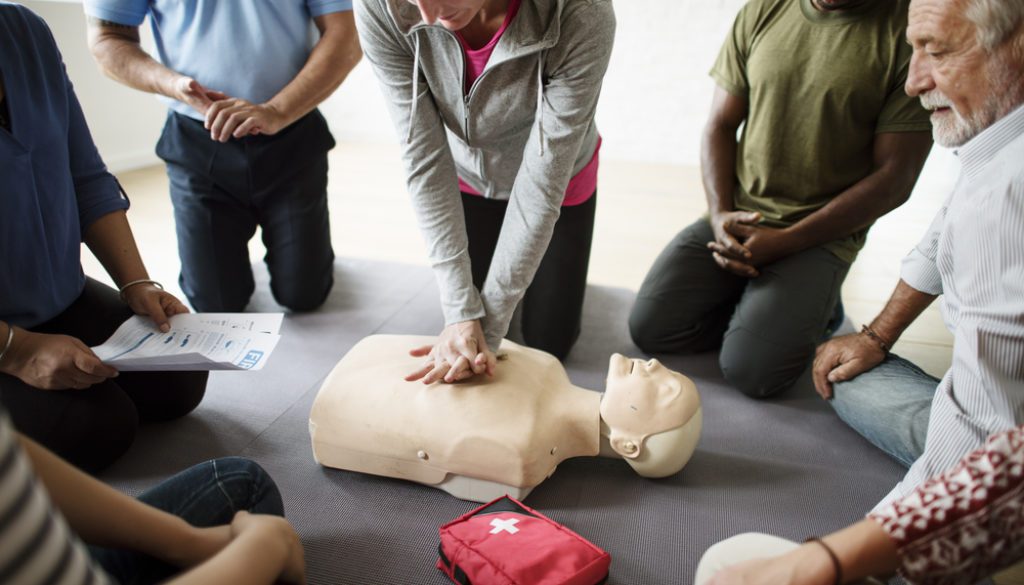February Safety Training: First Aid
Medical emergencies can happen at any time, and it’s crucial for employers to make sure they are prepared to handle such crises. Illnesses, mental health issues, accidents and violent incidents are just a few examples of crises that can have a significant impact on morale and production.
A well-defined emergency response plan can help mitigate some of the effects of a workplace crisis. It’s vital to ensure employees have a reliable means to contact internal security and 9-1-1. When paramedics and other first responders can’t get to the scene fast enough, first aid makes all the difference.
By offering first aid training to your employees, you can equip your workforce to respond to a medical emergency quickly and effectively. First aid training can help individuals feel safer and more confident in their ability to react in a crisis. Even something as simple as knowing how to bandage a wound can be a vital skill in an emergency.
Benefits of first aid skills
Occupational illnesses and injuries are more common than many people think. In 2020, there were 4,764 fatal work injuries in the U.S. In the same year, private industry employers reported 2.7 million nonfatal workplace injuries and illnesses (including cases of COVID-19).
While first aid training can’t eliminate all workplace injuries and illnesses, it can reduce the severity and mortality rate. For example, first aid can save the life of someone who is choking; a blocked airway can be fatal in 3 to 4 minutes, but it often takes longer for first responders to arrive.
First aid is critical in cardiac events also. Only about 46% of people who experience an Out of Hospital Cardiac Arrest (OHCA) get help before a first responder arrives. However, if Cardiopulmonary Resuscitation (CPR) is performed immediately, it can double or even triple the chance of survival.
First aid training and safety plans
First aid training isn’t just advantageous, it’s often necessary. Occupational Safety and Health Administration (OSHA) regulations require some employers to provide first aid training and supplies. Incorporating first aid courses into the annual safety training schedule ensures that employees get regular updates on critical topics.
Top first aid skills topics to cover
There are many different types of first aid skills, but it’s best to focus on the ones that are most useful.
- CPR and AED: Approximately 90% of individuals who experience an OHCA die, but immediate CPR can drastically increase the chance of survival. Likewise, survival chances double when an automated external defibrillator (AED) is used before first responders arrive.
- Heimlich maneuver: In the U.S., approximately 4,000 adults die yearly, but about three-quarters of choking victims recover after receiving the Heimlich maneuver.
- Wound care: Blood loss can be fatal in as little as 5 minutes, so knowing how to stop bleeding is a vital first aid skill.
Organizations in some industries may consider adding other relevant topics. For example, a manufacturing facility should ensure employees know how to utilize eye wash stations and care for an individual exposed to a toxic substance.
Protect your employees with comprehensive first-aid training
First aid training is extremely beneficial for schools, government organizations and businesses. It gives employees the skills to help and protect their colleagues, and it can improve morale. A first-aid-trained workforce can respond to various crises and potentially save lives. Along with first aid courses, employers must provide adequate first aid supplies and ensure employees know where they are located.
First aid can make all the difference when it comes to medical emergencies, but it’s just as important to make sure that employees get care from first responders as soon as possible. An effective safety plan must include emergency communication procedures and reliable tools that connect workers and managers with 9-1-1 and first responders. Rave Mobile Safety offers a range of critical communication solutions designed to protect people in all types of crises. To learn about our prebuilt tools or get information on building a customized solution, contact our team.





